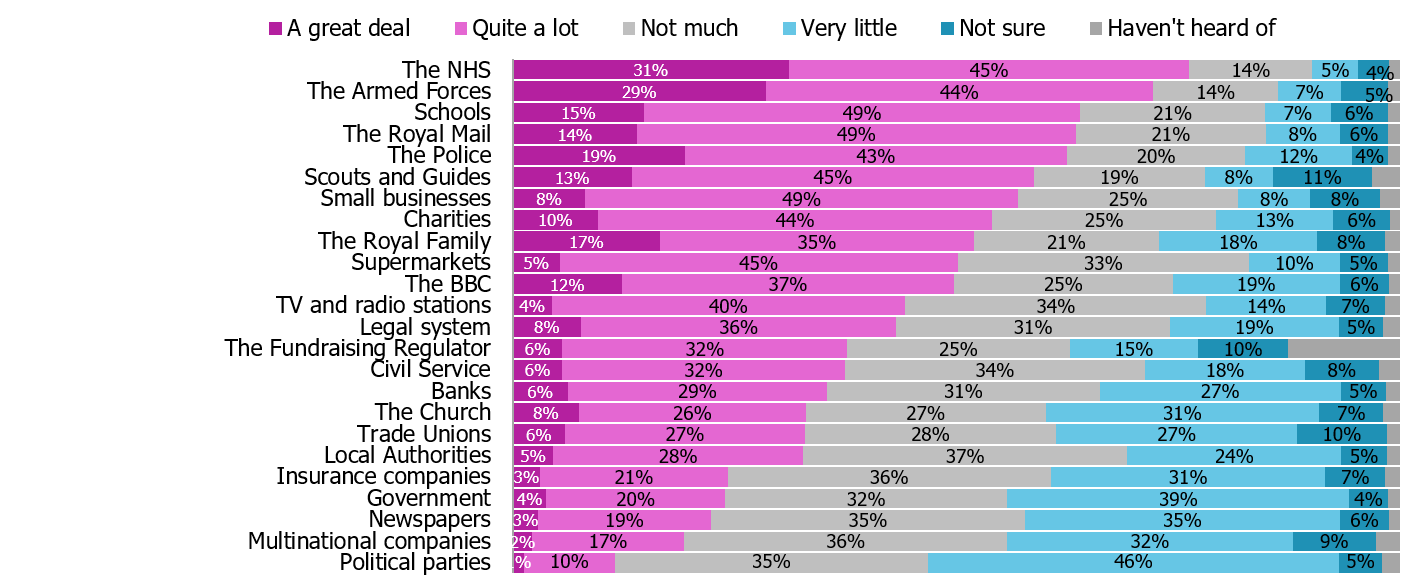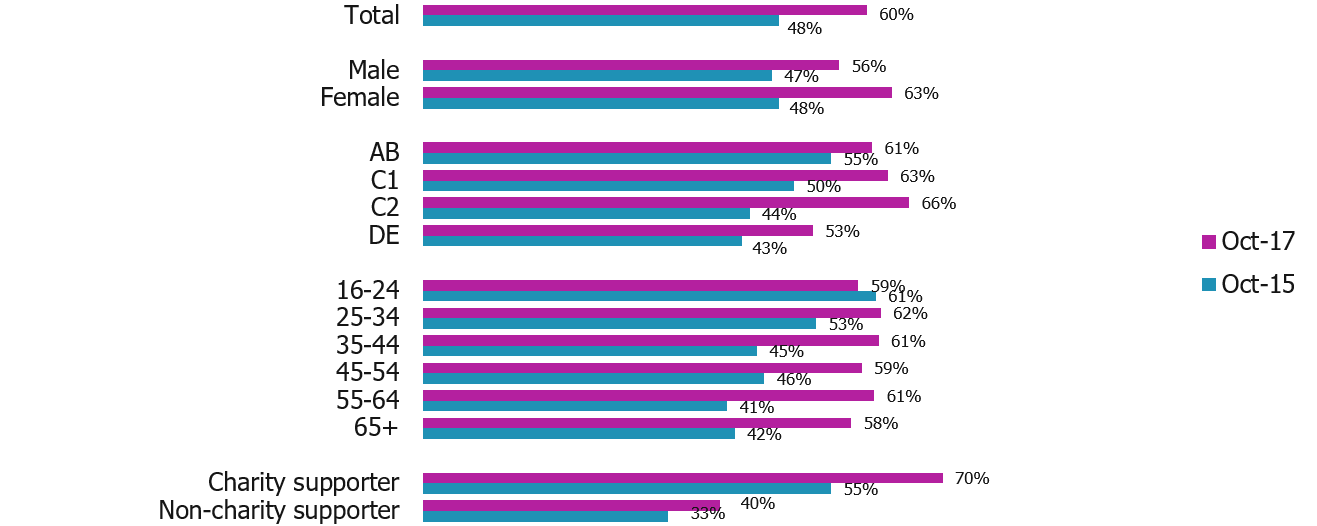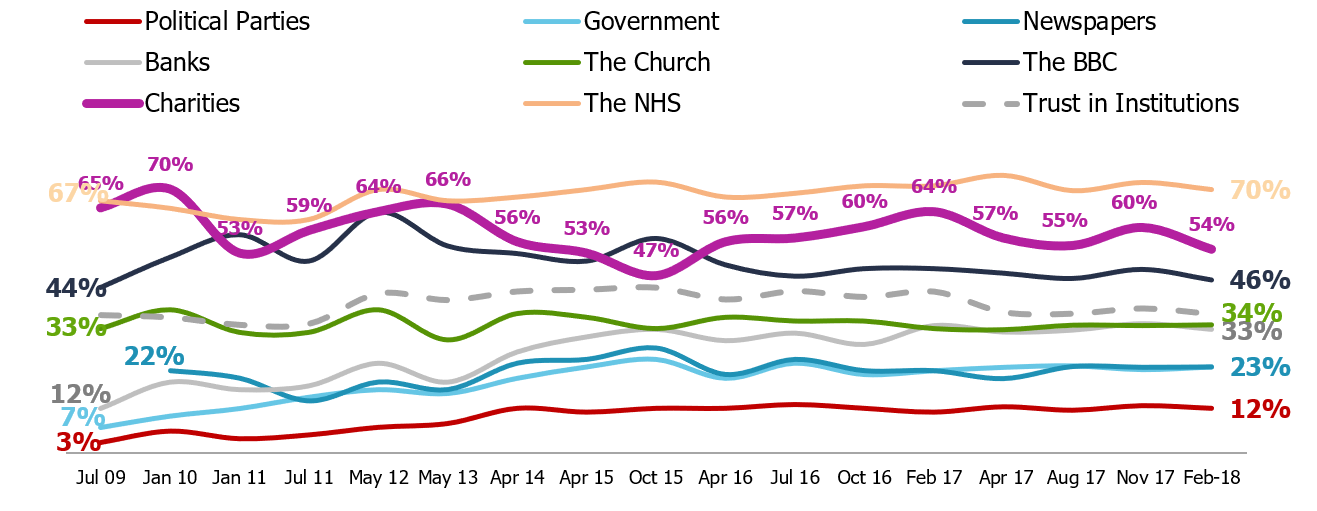*This briefing with data charts is available to download as a separate file.
Introduction
Baroness Stowell, the new Chair of the Charity Commission, declared in April that her main goal was to increase trust in charities during her tenure. There is a lot of information about trust in charities, and as nfpSynergy have been tracking trust in charities for longer and in more detail than any other organisation, we thought we’d provide a briefing on what we have found out.
The problem with trust in charities is that it’s much easier to provide research data about how charities are comparably more/less trusted than hairdressers/ strangers/ supermarkets/ etc than to understand what trust actually means for the sector. So this document sets out the characteristics of trust in charities, what drives it up or down, and how it might be possible to move it upwards. Finally, we ask whether trust is really the best barometer of public engagement with, and support for, charities. Our appendix sets out who researches trust in charities and how their approaches and results differ.
The characteristics of trust in public bodies and charities
Armed forces, schools and the NHS are universally trusted
Our research in chart 1 shows that the NHS (76% trust it a great deal or quite a lot) Armed Forces (73%), and schools (64%) are the most consistently trusted public institutions. Charities are typically in the group just behind them (see our latest research). A similar pattern is found with MORI research on professions which has nurses, doctors, teachers and judges the most trusted professions (they don’t ask about anybody from the military).
Politicians, Government and the media are universally less trusted
Politicians and the media are those who are amongst the least trusted in society. Our research shows political parties are trusted by 11%, and government and newspapers by 24% and 22% respectively. The MORI professions research shows that politicians, government ministers and journalists are all in the bottom four with trust of under 27%.
Chart 1: Trust in institutions in February 2018

“Please indicate how much trust you have in each of the bodies”
Source: Charity Awareness Monitor, Feb 18, nfpSynergy | Base: 1,000 adults 16+, Britain
Younger people trust charities more than older people
As a general rule, men and women tend to trust charities fairly equally and there is only a marginal greater trust by higher social classes than lower ones. The biggest demographic difference in trust is from young to old. Younger people (under 35s) tend to trust charities more than older people (over 45s), though in our latest research trust evened out fairly strongly between age groups. Chart 2 below shows the demographics of trust in October 2015 (when trust in charities was at a low ebb) and October 2017. Perhaps the most relevant point is that the dip in trust appears to have hit those groups that are more engaged in with charities: the over 45s and charity supporters (though not social class A/B). For example, trust among charity supporters was 55% in October 2015 and has risen to 70% in October 2017. Among non-supporters, it went from 33% to 40% in the same period.
Trust in charities is volatile – unlike some other institutions
One of the features of trust in charities is that it is volatile (see chart 3). So in the five years between 2010 and 2015 trust in charities saw a range of 23% percentage points (70% to 47%). Banks are also volatile – a low of 12% in 2009 and a high of 33% in 2015. In contrast some organisations like the NHS and the Church see much smaller variations (about 8 percentage points in roughly the same period) despite the fact that neither institution has been free from scandal or public scrutiny. The reasons for these differences in volatility are not clear.
Chart 2: demographics of trust in charities. Oct 2015 (the low point of charity trust) vs Oct 2017

“Below is a list of public bodies and institutions. Please indicate, by ticking in the appropriate column, how much trust you have in each of the bodies. Charities” A great deal or quite a lot
Base: 1,000 adults 16+, Britain | Source: Charity Awareness Monitor, Oct 2015 and Oct 2017, nfpSynergy
Trust decreases the larger and more non-specific the subject is
One of the features we see is that the bigger and more generic a subject is, the harder it is to trust them. This is really just common sense. If we asked you if trusted ‘everybody in Britain’, you’d be pretty unlikely to say yes. If we asked about all the people in the organisation where you work, or your family, you’d probably be increasingly likely to say ‘yes’. The same is true for charities. Charity causes are trusted a lot more than charities as a whole. In our most recent wave of research just 10% trust ‘charities’ a great deal but 39% trust cancer charities ‘a great deal’ and 37% trust ‘rescue services’ a great deal. Indeed, every sector bar overseas and religious charities have a higher level of trust than charities as a whole (see chart 4). This is a kind of synergy in reverse: the parts are more trusted than the whole.
The public distinguish between charity sub-sectors in terms of trust
Not all parts of the sector are seen in the same way by the public. Our recent data on how the different ‘causes’ are trusted shows a big difference between cancer, health, hospices and the like, being highly trusted (39% trust cancer charities ‘a great deal’). This is comparably much higher than the seemingly less trusted religious and overseas charities (just 10% trust overseas charities ‘a great deal’) (see chart 4). So any action plan may need to look at the particular issues that make some causes less trusted than others.
Chart 3: Trust in public institutions since 2009

“Below is a list of public bodies and institutions. Please indicate, by ticking in the appropriate column, how much trust you have in each of the bodies” A great deal or quite a lot
Base: 1,000 adults 16+, Britain | Source: Charity Awareness Monitor, Jan 09-Oct 17, nfpSynergy
What increases and decreases trust (in charities)?
Changes in trust have multiple drivers of change
What changes trust in any institutions probably has many drivers (though this is harder to prove in research terms):
- The first is the actions that an institution collectively undertakes – so the scandal about fundraising practices are a classic way that trust is influenced.
- The second way is what a member of that institution does – so when Kids Co scandal blew up it rubbed off on the wider charity sector.
- Third as other organisations are trusted less, charities are trusted more. For example, the increase in trust in charities from its low of 42% in 2007 to its high in 2010 are probably because banks, business and government had become less trustworthy as the financial crisis hit- people trusted charities more, because other institutions had let them down.
Chart 4: Trust in specific charity sectors

“Please indicate how much trust you have in charities working in each of the sectors”
Source: Charity Awareness Monitor, Feb 18, nfpSynergy | Base: 1,000 adults 16+, Britain
How much is ‘trust’ a good barometer of public engagement with charities?
While the sector is inclined (and the Charity Commission legally obliged) to focus on trust, there are reasons to think more broadly.
We don’t know what trust influences
Everybody tends to talk about trust as if a rise in trust is always a good thing, and a drop a bad thing. While rationally this would make sense, it’s worth pointing out that we have no evidence that rising levels of trust leads to rising levels of more tangible benefits for charities, such as giving or volunteering. The sector does need to be carefully about focusing too specifically on trust as if it were an end in itself- this hasn’t been proved.
Trust and confidence – we’re not confident there is much difference
We tend to lump trust and confidence together in a single phrase. The difference between the two is not very clear (trust is usually the more generic sentiment, confidence the more specific). Perhaps more importantly we’ve had very little insight that advises us on changing one rather than the other. If the two are always lumped together, perhaps we should just talk about trust.
We need other measures to understand the health of charities
Following on from the previous point, alongside trust we need other measures to explore the health of the sector. These could be about the growth in income of different size of charities, levels of individual giving and volunteering, the number of new charities, and perhaps most difficult of all the difference that charities make. Equally we could measure whether people consider them a supporter of charities collectively and any specific charities. By including other measures, we can have a better understanding the range of factors that can shape the health of charities.
How can we increase trust in charities?
The first thing to say is that Baroness Stowell, or even the Charity Commission on their own, can’t drive trust up. It will take a multi-party, multi-faceted effort.
Create a powerful cross-sector task force
Up till now the Commission has seen its role in trust as being regular research and effective regulation. To increase trust in charities we need a task force, chaired by Baroness Stowell, to make sure we undertake all the activities that will increase trust, and tackle all the issues that will drive trust down. Both these are important but only a part of the picture. To guide this process, we need to get sector bodies, fundraisers, researchers, influencers, comms directors, CEOs and more round the table, to co-ordinate and drive activity. The Understanding Charities Group started on this process, but the initiative has not progressed since ACEVO and NCVO took it over.
Agree what success looks like
Yes, trust is important, but it’s really a proxy for something else: the warmth and engagement and support that the public have for charities. It is no good if trust goes up, and giving or volunteering or campaign support or use of charity services is unaltered. Trust is a means to an end, and the end is the public and politicians embracing and supporting charities. We need to agree how we define that and measure it.
Create better way to understand charities’ performance
The public has a thirst to understand better how well a charity they give to is doing. They want to know how much is spent on ‘admin’ and ‘fundraising’. In effect they want to know how much of their money goes on the ‘cause’. There are many in the sector who argue this approach is muddle-headed: all money goes on the cause one way or the other. The problem is that nobody is really making that argument with donors or the public, nor is anybody making it easier for the public to find out what they want to know. The long, over-complex and often incomprehensible annual reports and accounts that SORP dictates are part of this problem (see our "SORPed out" report for more details).
It’s also possible to help the public compare charities of the same type. It’s no good comparing the financial data for a charity that gets most of its money from government (eg Mencap) with one that gets most of its income from donations (eg Macmillan).
So we need better ways to help the public to understand charities’ financial and mission performance.
Make the Charity Commission, and what it does, better known
Our research with donors shows that they are reassured about charities when they hear more about the work of the Charity Commission and even its existence. So making the Charity Commission better known is a key way that we can reassure donors – and eminently practical.
Identify and address the Achilles heels we know about
The charity sector is deeply conservative. It hates change. It hates conflict. We may like to have a go at politicians or companies, but we certainly don’t like having a go at our practices that need reform. We seem to turn a blind eye to many of the sector’s failings.
This is how fundraising drove into a brick wall when the Olive Cooke affair hit. Ask any donor and they say they didn't like the way they were treated. I even wrote blogs asking why the sector was in denial about fundraising aggravation five years ago. But it took a media scandal to force action. The same with the safeguarding issues in the overseas sector, or the problems at Kids Company. It took media scrutiny for action (so it is deeply ironic when the sector complains about being driven by ‘red top coverage’, because there is nothing much else that can make it change.)
We need to sort out the woeful state of charity accounts which are too long and full of jargon to be explicable to all but accountants or the most dedicated of donors. We know there is a looming pension crisis. Many trustee boards don’t do their organisations justice. We need to start tackling these issues.
Be prepared for media scrutiny
The sector needs to get better, and more accepting, of media scrutiny. We have improved in the last few years, largely through the work of CharityComms. They have a dedicated LinkedIn group to provide a ‘heads-up’ about stories and through the free workshops they run for small charities that provides media training. That said if the part of the sector under scrutiny doesn’t have the media resources, like the overseas development sector during the safeguarding crisis, there could be a much patchier and un-certain response.
Defend CEO pay, fundraising costs, and other key issues
There are some things that we do need to change in the sector (see above) but there is much that we don’t. So we do need to continue to explain, explain, explain why paying CEOs of our largest charities £125k a year is a bargain, and why charities have to invest in fundraising to raise money, and deliver more for their cause. Effective communications strategies are critical for these key areas that the sector has to make a strong case for.
You can download this briefing with data charts below. If you are interested in setting up a bespoke tracker for your charity, just drop us a line here.
Appendix: Who researches trust in charities and what are the differences between them.
CAF, nfpSynergy, Edelman, MORI, the Charity Commission and others all research about trust in charities.
Charity Commission do trust research usually every other year usually both quantitative and qualitative (https://www.gov.uk/government/publications/trust-and-confidence-in-the-charity-commission-2017). This measures trust in charities on a scale of 1 to 10 and the current results show an average of 6.0 the same as in 2015. They put awareness of the Charity Commission at 61% and suggest that 12% of the public has used the Commission’s website.
Ipsos-MORI do a research into professions called the Veracity Index (Details can be found here. https://www.ipsos.com/ipsos-mori/en-uk/politicians-remain-least-trusted-profession-britain ) Their research asks about doctors, clergy, teachers, etc etc and charity Chief Executives. This put charity CEOs in the bottom half of the table possibly reflecting the fact that charity CEO pay has been in the news.
Edelman found NGOs have a higher trust rating than any of the others sectors they measure – government, business and the media - both globally and in the UK. The Edelman research (source https://www.edelman.co.uk/magazine/posts/edelman-trust-barometer-2018/ ) works in a different way from other trust research. Firstly it asks about ‘NGOs’ not charities, which is probably a less familiar term and tends to mean overseas development charities in the UK at least. It also researches just four sectors: business, government, NGOs and the media: compared to the 30 or so institutions that our research asks about. The question is do you trust xxx ‘to do the right thing’ which is different from asking about trust generally.
CAF does monthly tracking of trust in charities. Details can be found here. https://www.cafonline.org/about-us/media-office-news/levels-of-trust-remain-consistent-despite-recent-reports-about-charities
nfpSynergy researches trust in charities four times a year, and has been researching trust in charities (at least once a year) since 2006. Our latest briefing can be found here.
An excellent piece, summed up
An excellent piece, summed up in the phrase 'The sector does need to be carefully (sic) about focusing too specifically on trust as if it were an end in itself'. You can't raise trust levels by focusing on 'trust' - focus on transparency, responsibility, activity, competence, ethical behaviour and relevance (TRACER) - and trust will follow.

